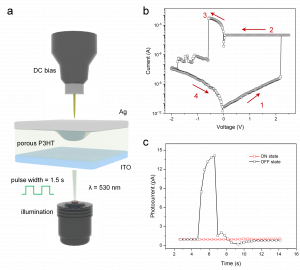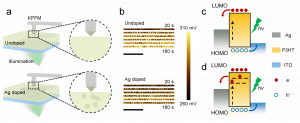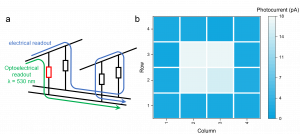A Memristive-Photoconductive Transduction Methodology for Accurately Nondestructive Memory Readout

a, device structure diagram. b, Electrical storage features of the device. c, Optical response of the device.
USA, September 3, 2024 /EINPresswire.com/ -- Scientist in China proposed a Memristive-Photoconductive Transduction (MPT) strategy to achieve crosstalk-free readout. By utilizing the characteristic that the photoelectric response of the semiconductor resistive memory device varies under different resistance states, precise and nondestructive readout operations can be achieved in a crossbar memory array. This innovative MPT strategy is expected to be applied in high-density storage and large-scale neural network computing.
Resistive memory array with cross-point structure has great potential for high-density information storage and large-scale neural networks. However, the crosstalk caused by the leakage current flowing in adjacent cells may limit array size, increase system consumption, and reduce fault tolerance. To alleviate this issue, several configurations, including one transistor-one resistor (1T1R), one diode-one resistor (1D1R) and one selector-one resistor (1S1R), have been developed by integrating cell with additional switching or rectifying units. Despite avoiding the distortion of data stored in selected cell during a reading operation, these existing approaches considerably complicate circuit design and manufacturing process. Complementary resistive switching is also a significant way that blocks sneak current effectively while suffers from a destructive readout. In light of the drawbacks of prevailing strategies, exploiting new method to accurately and nondestructively read memory within crossbar design is highly demanded.
In a new paper published in Light Science & Applications, a team of scientists, led by Professor Wei Huang and Juqing Liu from Key Laboratory of Flexible Electronics & Institute of Advanced Materials, Nanjing Tech University, and co-workers have discovered a Memristive-Photoconductive Transduction phenomenon, wherein the formation and breakage of conductive filaments within the memory unit under bias not only causes the device to switch between high and low resistance states, but also causes the device to exhibit different photoelectric responses under different resistance states. Furthermore, by utilizing this feature, precise and nondestructive readout were achieved in a crossbar integrated memristor array.
Researchers fabricated memristive device with photo-electric dual response using typical organic semiconductor material P3HT as memristive medium. The device can transition from the initial high-resistance state (HRS) to the low-resistance state (LRS) under positive bias, and return to the HRS under negative bias. When light stimulus is applied to the device, a noticeable photoelectric current can be detected when the device in HRS, while the photoelectric current disappears when the device in LRS.
By analyzing the photocurrent relaxation time of the device under different bias voltages and scanning times, as well as employing STEM and KPFM techniques, it was demonstrated that the resistive behavior of the device originated from the gradual diffusion of silver from the top electrode into the resistive medium P3HT under electric field. This diffusion led to the formation of metal conductive filaments internally, connecting both electrodes. Simultaneously, residual silver clusters within P3HT acted as trapping centers for photo-generated carriers, resulting in a prolonged photocurrent relaxation time.
When the storage unit in HRS, the photo-generated charge carriers are effectively separated by the built-in electric field, resulting in a measurable photoelectric current. Upon switching to LRS, the built-in electric field vanishes due to the short circuit formed by the conductive filament connecting the two electrodes. Consequently, effective separation of photo-generated charge carriers becomes hindered, leading to an absence of photocurrent. Finally, researchers have fabricated a 4*4 resistive storage array and employed this MPT method for precise sensing of resistance states in all 16 storage units.
DOI
10.1038/s41377-024-01519-w
Original Source URL
https://doi.org/10.1038/s41377-024-01519-w
Funding information
This work was supported by the National Natural Science Foundation of China (62274088, 62288102), the Project funded by China Postdoctoral Science Foundation (2023M741657), the Jiangsu Funding Program for Excellent Postdoctoral Talent (2023ZB554), and the Jiangsu Specially-Appointed Professor programme.
Lucy Wang
BioDesign Research
email us here
Legal Disclaimer:
EIN Presswire provides this news content "as is" without warranty of any kind. We do not accept any responsibility or liability for the accuracy, content, images, videos, licenses, completeness, legality, or reliability of the information contained in this article. If you have any complaints or copyright issues related to this article, kindly contact the author above.


